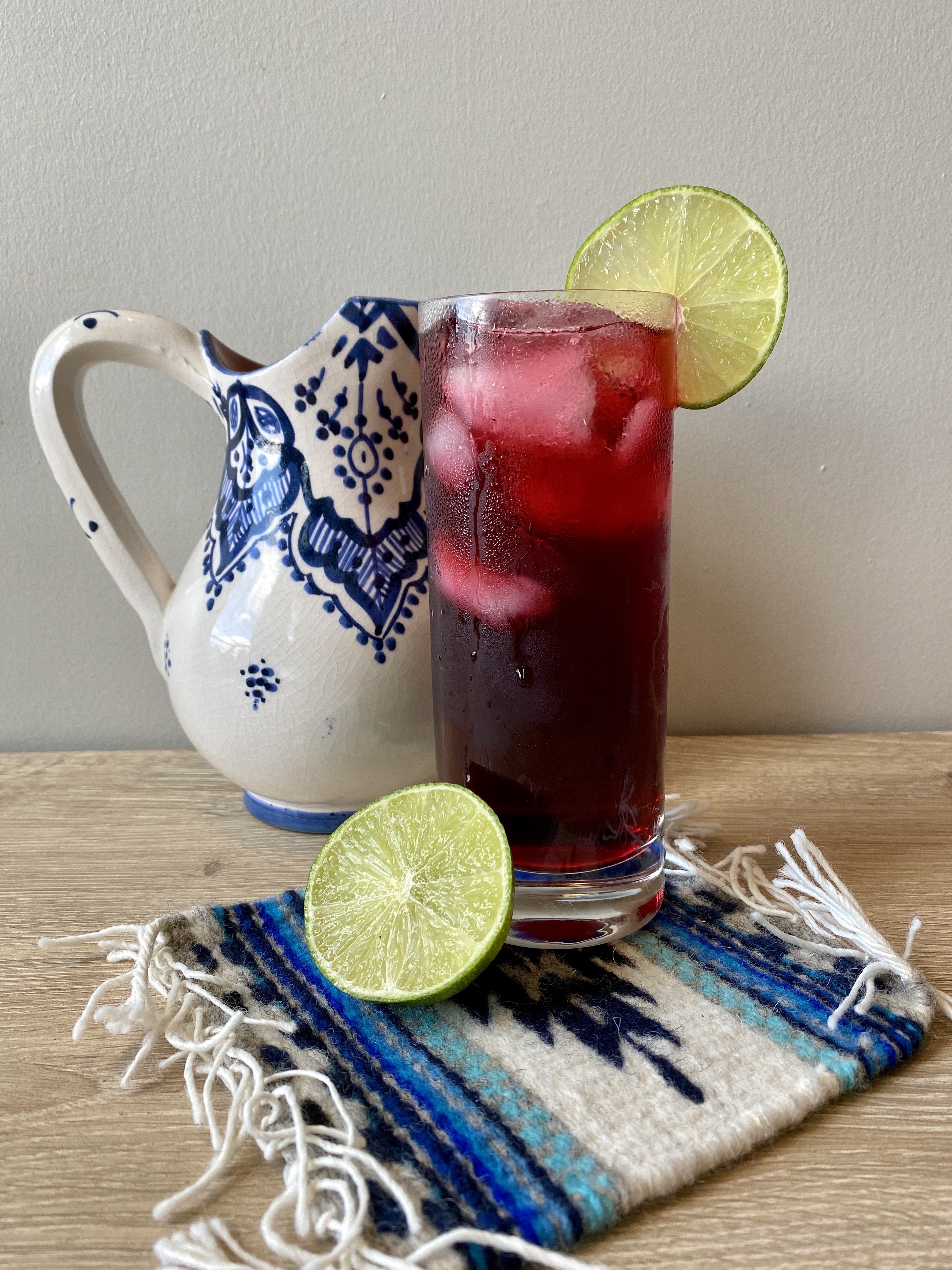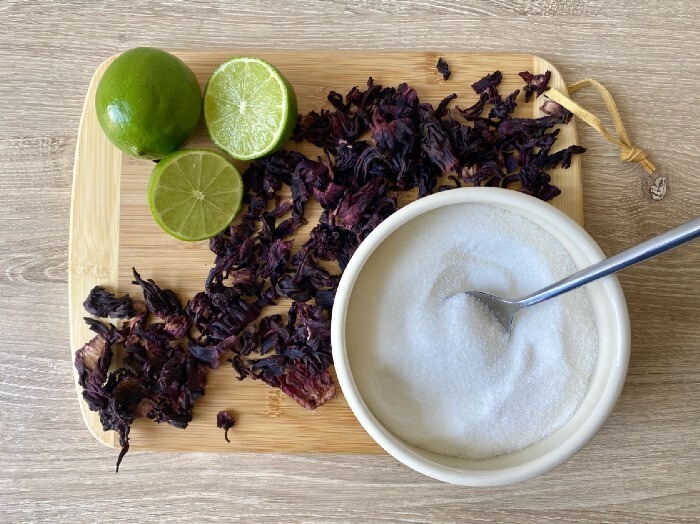
Historias de la Cocina: Agua Fresca de Jamaica (Hibiscus Tea)
A love letter to Calle Olvera, Los Angeles summers, and the sweetness of agua fresca.
Summer will tragically be coming to an end soon. I am not ready to face that reality yet, so until I come to terms with the changing of the seasons, I will be happily sunbathing in denial and sipping nothing but aguas frescas — specifically agua fresca de jamaica — all day long.
When steeped and sweetened, flores de jamaica (hibiscus flower, pronounced ha-may-kah) gives off intense fruit punch vibes. If you’ve ever had it, you know that it can easily be mistaken for a mixed berry drink like a cran-raspberry cocktail. A glass of agua de jamaica is everything you need for a bit of escapism — while drinking it, I like to pretend like summer is endless and that I’m having a drink in the Southern California sun.
Aguas frescas (translated literally: fresh waters) are drinks made of fresh fruits, sugar, grains, or herbs — often blended with ice cold water and lime juice. They are popular in a number of Latino cultures, but some of the most famous ones, like horchata and jamaica, are quintessentially Mexican. In many parts of Mexico, aguas frescas are consumed year-round, with flavors varying depending on what fruits or flowers are in season. Flavors like jamaica, mango, pineapple, and watermelon are usually served in the summer, when they are in season and easily accessible. I’ve seen winter agua frescas in California made with orange and tangerine.
Mexican folklore says that the first agua frescas were made by Aztecs, from fruits gathered around Tenochtitlán and chilled with ice from nearby dormant volcanoes, Popocatépetl and Iztaccíhuatl. Though not native to Mexico (the flowers have a disputed origin between Africa and India) jamaica flowers came to the country during colonial times. A traditional remedy for high blood pressure, the flowers are most popularly steeped into a concentrate and used in agua frescas and paletas (Mexican popsicles).
I can’t think of agua de jamaica without thinking of Calle Olvera, the beloved Mexican marketplace, in Downtown Los Angeles. Part of the El Pueblo de Los Angeles Historic Monument, Calle Olvera is a narrow block full of vibrant puestos (market stalls), museums, and hole-in-the-wall cafes. My family trips to Olvera Street consisted of browsing the handmade pottery, jewelry, and leatherwork sold by the vendedores, many of whom are descendants of the original Calle Olvera sellers of years past. We admired the delicate embroidery on traditional folklorico dresses and listened to live mariachi music in the plaza. When I was young, Calle Olvera was a place for me to learn about my heritage through art and food. I bought countless trinkets and enjoyed Mexican street food — my favorite part of the marketplace — while my mom and grandparents taught me the history of Chicano people in Los Angeles, and how I was a part of it.
As the oldest section of Los Angeles, the market has kept Mexican culture and traditions alive for nearly a century, with festivals like Día de los Muertos and Las Posadas, a nine-day Christmas celebration. But due to the Coronavirus, Olvera Street has been shut down since March, with the exceptions of a few restaurants that have switched over to takeout and delivery. Merchants are struggling, with many asking the city of Los Angeles for help with rent. Vendors have fallen behind on their payments in recent months, threatening the future of Calle Olvera as a whole. I fear that this will happen, especially as I think about all the beautiful memories my family and I have made at the marketplace and the connections with certain dishes that our trips have created.
We finished every Calle Olvera trip with a meal at Cielito Lindo, a tiny stall cafe specializing in freshly-made taquitos and avocado salsa (which is still open for takeout and delivery, I might add). The restaurant is endearingly cramped with a few metal tables scattered in a three-walled dining room that is fully open to the marketplace in the front. The walls, slated with hand-painted Talavera tiles, showed off delicately painted flowers in vibrant shades of pink — the ideal backdrop for an equally vibrant meal.
My order at Cielito Lindo was always the same: chicken taquitos — topped with sour cream and avocado salsa — and a large agua fresca de jamaica. The jamaica was displayed in an oversized, clear-glass agua fresca barrel, alongside other aguas like horchata (sweet rice milk with cinnamon) and agua de tamarindo (tamarind punch). The beverages were served in a large styrofoam cup, filled to the brim with crushed ice, and topped off with a red plastic straw. That disposable vessel of hibiscus tea was the most welcome respite from the sweltering Los Angeles heat, and a symbol of family outings.
My draw to agua de jamaica at this time has as much to do with my grandparents as it does with family trips to Calle Olvera. Agua de jamaica was more than a family outing treat. In the summers, there was almost always a pitcher of the floral-fruity punch brewing in my grandparents’ home. I remember my abuelo as the primary agua-maker, but my abuela argues that she was the one who always made it. Regardless of the real agua fresca master’s identity, everyone in my family gladly gulped down the deep magenta-colored tea whenever it made an appearance in an opaque plastic drink dispenser, ready to be served over ice.
In the summers of my childhood, I would regularly spend a week or two at a time at my grandparents’ home in The Valley of Los Angeles. Both retired, they would make every effort to keep me entertained while I was out of school. In the evenings, my abuela would lay out a cotton sheet on the grass in her front yard for us to sit on. My abuelo would lounge in a lawn chair on the porch. We all drank cups of agua de jamaica over ice, watching the sun sink below the Sweet Gum trees that lined their street.
There is little hope for a trip home any time soon, and even less hope for another meal at Cielito Lindo, so I often find myself longing for a bit of that hot-weather nostalgia. I wish I could be eating taquitos and chile rellenos with my family on floral Talavera-tiled tables and laughing over tart, sweet, agua de Jamaica, but because of this pandemic, it may be a long time until I can do that again. Making agua de jamaica is not just a grab for what is left of the fading summer for me (which it definitely is), but also an act of easing my yearning for my family.
Even if you don’t have the same sentimentality for aguas frescas that I do, agua de jamaica is worth the time it takes to make. A wonderful alternative to pre-made fruit punch and fruit juices, steeped jamaica is a thirst quenching drink perfect for a hot summer day. The sweetened tea can also be used to flavor alcoholic cocktails.

Photo of dried hibiscus flowers, lime, and sugar by Jae Thomas.
Agua Fresca de Jamaica (Hibiscus Tea)
Yield: 6 cups
Time: Roughly 1-2 hours (includes steeping and cooling time)
Ingredients
- 1-1 ½ cups dried flores de jamaica (hibiscus flowers)*
- ½-⅓ cup granulated sugar
- Juice from half a lime (or more, if desired)
*The strength of your agua fresca will depend on how fresh your dried flowers are. Older flowers are less potent, so adding a larger amount will lead to a better flavor.
Preparation
Step 1
Add dried flowers to a large pot and cover with 7-8 cups of cold water. Bring to a boil.
Step 2
Once water is boiling, remove from heat and let the flowers steep, anywhere from 30 minutes to a few hours, depending on desired strength. The longer you steep, the stronger the agua fresca will be. You can even steep it overnight, if you want a richly flavored tea.
Step 3
Let the mixture cool to room temperature, about 30 minutes. Once cool, strain and discard the flowers. Pour liquid into a large pitcher or jar.
Step 4
Squeeze in the juice from half a lime. Then, pour in sugar, ¼ cup at a time. Sweeten to taste, adding more lime juice and diluting with water, if desired. Serve over ice.


